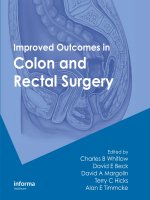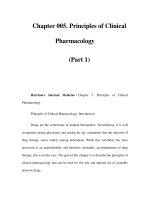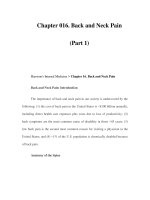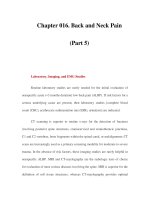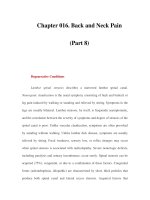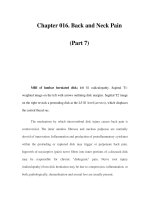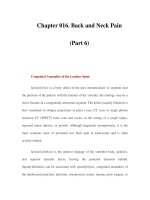Chapter 033. Dyspnea and Pulmonary Edema (Part 1) pps
Bạn đang xem bản rút gọn của tài liệu. Xem và tải ngay bản đầy đủ của tài liệu tại đây (31.45 KB, 5 trang )
Chapter 033. Dyspnea and
Pulmonary Edema
(Part 1)
Harrison's Internal Medicine > Part 2. Cardinal Manifestations and
Presentation of Diseases > Section 6. Alterations in Gastrointestinal
Function > Chapter 33. Dyspnea and Pulmonary Edema
Dyspnea
The American Thoracic Society defines dyspnea as a "subjective
experience of breathing discomfort that consists of qualitatively distinct sensations
that vary in intensity. The experience derives from interactions among multiple
physiological, psychological, social, and environmental factors, and may induce
secondary physiological and behavioral responses." Dyspnea, a symptom, must be
distinguished from the signs of increased work of breathing.
Mechanisms of Dyspnea
Respiratory sensations are the consequence of interactions between the
efferent, or outgoing, motor output from the brain to the ventilatory muscles (feed-
forward) and the afferent, or incoming, sensory input from receptors throughout
the body (feedback), as well as the integrative processing of this information that
we infer must be occurring in the brain (Fig. 33-1). A given disease state may lead
to dyspnea by one or more mechanisms, some of which may be operative under
some circumstances but not others.
Figure 33-1
Hypothetical model for integration of sensory inputs in the production
of dyspnea.
Afferent information from the receptors throughout the respiratory system
projects directly to the sensory cortex to contribute to primary qualitative sensory
experiences and provide feedback on the action of the ventilatory pump. Afferents
also project to the areas of the brain responsible for control of ventilation. The
motor cortex, responding to input from the control centers, sends neural messages
to the ventilatory muscles and a corollary discharge to the sensory cortex (feed-
forward with respect to the instructions sent to the muscles). If the feed-forward
and feedback messages do not match, an error signal is generated and the intensity
of dyspnea increases. (Adapted from Gillette and Schwartzstein.)
Motor Efferents
Disorders of the ventilatory pump are associated with increased work of
breathing or a sense of an increased effort to breathe. When the muscles are weak
or fatigued, greater effort is required, even though the mechanics of the system are
normal. The increased neural output from the motor cortex is thought to be sensed
due to a corollary discharge that is sent to the sensory cortex at the same time that
signals are sent to the ventilatory muscles.
Sensory Afferents
Chemoreceptors in the carotid bodies and medulla are activated by
hypoxemia, acute hypercapnia, and acidemia. Stimulation of these receptors, as
well as others that lead to an increase in ventilation, produce a sensation of air
hunger. Mechanoreceptors in the lungs, when stimulated by bronchospasm, lead to
a sensation of chest tightness. J-receptors, sensitive to interstitial edema, and
pulmonary vascular receptors, activated by acute changes in pulmonary artery
pressure, appear to contribute to air hunger. Hyperinflation is associated with the
sensation of an inability to get a deep breath or of an unsatisfying breath. It is not
clear if this sensation arises from receptors in the lungs or chest wall, or if it is a
variant of the sensation of air hunger. Metaboreceptors, located in skeletal muscle,
are believed to be activated by changes in the local biochemical milieu of the
tissue active during exercise and, when stimulated, contribute to the breathing
discomfort.
